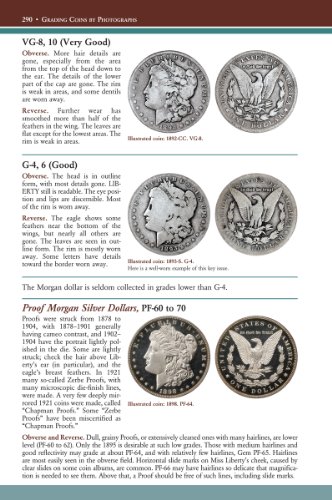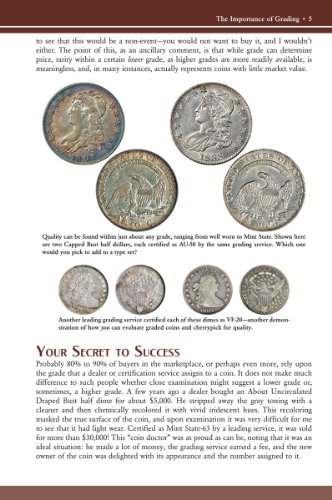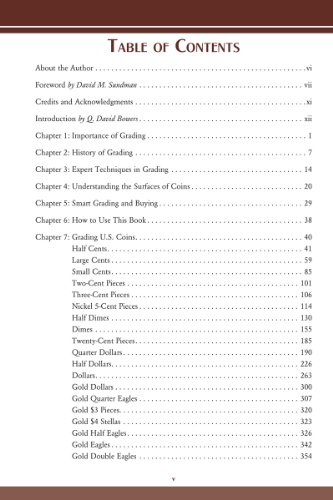




Grading Coins By Photographs
S**N
Great Companion Grading Guide, Needs Some Improvements
Grading Coins by Photographs by Q. David Bowers fills some voids left by other coin grading books, but due to photo selection and quality control issues, it falls short as a stand-alone grading guide. There are some nice features that make it a great companion to other grading guides, especially the cherrypicking advice in some of the introductory sections for each coin type. With some improvements, a third edition could be the best coin grading guide published.All the coin photos are in color, and most of them are very nice. As seen in all coin grading guides, the clarity of the photos varies from sharp to blurry. Unfortunately, there are five pixelated images; on pages 153 (two images), 168, 169 and 182 that render them useless. If it were not for these pixelated images, I would rate the overall image quality better than the ANA Grading Standards book. To be fair, the ANA Grading Standards book has its share of blurry photos, but no pixelated ones.Interestingly, black and white photos, which offer higher contrast (in print), likely would have brought out more details critical to grading for many of the images in the book. Given the choice between the two, I would have chosen black and white for the grading photos, and color for special features sections. The color photos generally worked well in this book for the uncirculated coins, the copper coins, and the lower grade and toned silver and gold coins. The color photography is especially problematic for mid-grade gold coins since they don't tone as much and they are more reflective. The poor contrast of the VF Classic Head Half Eagle, for example, makes this image very difficult to use.Grading Coins by Photographs has the welcome feature of specifying the exact grade of each coin pictured, which the ANA Grading Standards book does not do. Standard grading increments (3, 4, 8, 12, 20, 40, 50, etc.) are shown most of the time, but intermediate grades are shown in place of standard grades in many places. For example, a VF-30, or even VF-35 specimen may be shown in the very fine grade for one coin design, and a VF-20 example may be shown for another coin. I think this inconsistent incrementation of grading photos is one factor that makes this a great companion book to the ANA Grading Standards book but not a replacement for it.An issue with Grading Coins by Photographs that potential buyers should be aware of is the use of split-grade specimens (one side grades higher than the other). In the "How to Use This Book" chapter, the text says "There are no composite photographs. In each case the obverse and reverse illustrations are from the same specimen." Strictly adhering to this principle results in the use of some split-grade illustrations, so one of the two sides does not technically represent the grade. Additional notes below some of these photographs (a few noted in the early coppers) state that one side grades higher than the other. This gives the book a "case study" feel, which I like, but again, only as a complimentary book, not a stand-alone one. Split-grade examples hurt the book from a technical grading standpoint because, in each case, it deprives the reader of a diagnostic photo for grading one side of the coin. These cases should have been featured in a separate section on grading problems.The photos in the Classic Head half cent section are confusing, and a side-by-side comparison with the ANA Grading Standards photos is bewildering. The VF photo pairing is an example of a split-grade specimen without a disclaimer saying so. The obverse grades slightly better than the pictured EF obverse, and probably would grade AU if graded separate from the reverse (judging by the ANA illustration). The additional notes below the VF coin state that the hair shows significant wear, but the illustration absolutely does not show significant wear in the hair. So in this case, the book does not show an image of a VF obverse Classic Head half cent.In the Type 1 Standing Liberty Quarters section, the EF and VF photo sets appear to be reversed. The full length of Liberty's leg is flat in the EF image, and rounded in the VF image.There are some positive developments in Grading Coins by Photographs. The introductory chapters are filled with insightful and useful information on subjects such as coin surfaces, cleaning, and restoring cleaned coins. The chapter on "Smart Grading and Buying" advises going "Beyond the Grade" by considering fullness of strike and planchet quality. This chapter is similar to one in the ANA Grading Standards book, but done better by Bowers.The most helpful reading in Grading Coins by Photographs, to me, is Bowers' forward-thinking comments, particularly in the introductory section for each coin type. Here, Dave states his observations of professional coin grading tendencies, what improvements he thinks the grading services can make, and how we can benefit by cherrypicking certain coins before the grading services make these improvements. For example, in the Walking Liberty Half intro he states: "If certification services ever recognized and tagged full details coins, or even those with 90% details, prices would explode for issues that are very rare if well struck!"
G**C
Excellent book for dealing with grading
Excellent book for dealing with grading. Several photos of the same coin to all for a better understanding of how coins are graded including discussions of the most of the finer points of coin making and errors in the process. minor variation in coin grading are also covered in considerable detail. Also, it is pointed out that the process is not without variation by experts where coins are graded a different levels by different experts(?).The author points out that time and a lot of grading is required to be an expert. However, the overall value of the book to "non-experts" is that it gets one into the ball park of the grade of a coin plus of minus a few grades one way or another. If one has a very valuable coin it only make sense to have it professionally graded.
B**.
Don't waste your money if you own the first edition.
I'm giving this review 5 stars because this is a great book that every numismatist should own. BUT...Don't bother buying it if you own the first edition. The new color pictures are not an improvement over the black and white ones, and in fact are not as good in many cases. Black and white shows the details better. It also appears that they simply substituted color pictures of the same coins, rather than finding better examples. In a side by side comparison I could find no differences in the descriptions of the various grades for any of the numerous coins I checked. Q. David Bowers implies in the introduction that there are more detailed descriptions in this edition. I couldn't find any.In short, it is a waste of money to buy this edition if you have the previous one.
G**.
Awsome book to have. Even for the average numismatics
Great tool to have
T**.
Buy this book before you buy a coin
The photographs in this book help a coin buyer decide whether his or her coin is a BU slider or is actually an AU (almost uncirculated) coin, for instance. Grading is tough. It takes years of practice looking at hundreds of coins. Q. David Bowers' advice is top notch, as always. If he were a coin, he'd be an MS70. Before spending money on a coin that may be over graded or cleaned or worse (whizzed), read this book over and over. Compare your current coins and pocket change to the photographs shown. Please don't be upset if you find out your coin is a Good 4 and not a Fine 12. I've been there, many collectors have been there. The best defense against fraud and abuse in coin collecting is knowledge. This is a great book to have in any coin collector's library.
S**K
Paper version much easier to use.
The book content itself is excellent. I have no reservations on purchasing it. However, the kindle version is not the best platform to use. It is hard to instantly pinpoint specific coins. If the table of contents would hyper link specific coins instead of just types of coins it would be much easier to use. Example: Say you want to look at grades for walking liberty half dollars, you have to select half dollars and then browse until you get to the coin in question. It sounds like a little thing but it can be very frustrating. Also, I was somewhat disappointed with the photo quality when enlarged. It is not atrocious but can be very blurry. That said it is nice, however flawed, to have this kindle copy wherever I go.
J**Y
Coin grading
Good reference guide to get a clear understanding of coin grades and a good learning experience. Recommend to everyone who collects coins.
I**T
The Master writes again...
Without a doubt, Bowers is one of the prolific and respected numismatic authors of our generation. His material is not only accurate, and authoritative, but well written and easy reading--as well as very informative. Only i warn you, once you read a book by Bowers, you'l want to get any others written by him in your areas of collecting interest. I just purchased this Grading by Photographs book to help grade a roll of circulated V Nickels i bought, and it was a great help--speeding up the p process quite a bit. . .I'm sure I'll e buyng more of Bowers , just as soon s I get through this one. You will probably not be disappointed..
J**N
Coin Book
Good book but not a lot of detail
S**R
Five Stars
Great resource to have handy
Trustpilot
2 days ago
2 months ago